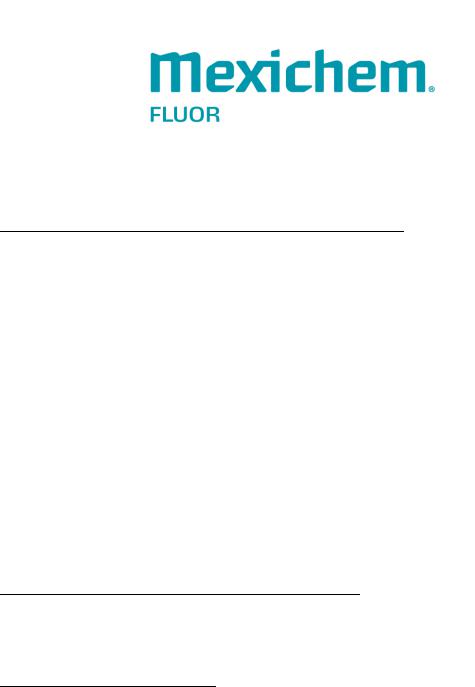Summit FF1427W, FF1161KSIM, FF1161KS, BKRF1159SS, BKRF1119B User Manual
...
MATERIAL SAFETY DATA SHEET
1.CHEMICAL PRODUCT AND COMPANY IDENTIFICATION
Product Name: |
KLEA®134a |
Product Use: |
Refrigerant |
Alternate Names: |
Fluorocarbon 134a, R-134a, HFC-134a, HFA-134a |
Manufacturer: |
Mexichem Fluor Inc. |
|
4990B ICI Rd. / P.O. Box 30 |
|
St. Gabriel, LA 70776 |
Medical Emergency (24 hr.): 303-389-1418
Transportation emergency (24 hr.): CHEMTREC 703-527-3887 CODE: INEO Product Information: (81) 8386-1705
Emergency: (81) 1482-0936
In Mexico In Case of a Chemical Emergency: Spill, Release, Fire, Explosion, or Accident Call the SETIQ Day or Night
01-800-00-214-00 (call free from any place in Mexico) or
01-55-59-15-88 (in Mexico City)
2.COMPOSITION/INFORMATION ON INGREDIENTS
Ingredients: |
%(Wt) |
OSHA PEL |
1,1,1,2-tetrafluoroethane (CAS 811-97-2) |
100 |
Not listed |
3. HAZARD IDENTIFICATION
EMERGENCY OVERVIEW:
CAUTION! This product is a clear, colorless, liquefied gas. Contents under pressure. Cylinders may rupture and rocket under fire conditions. Thermal decomposition can produce toxic and corrosive gases. Vapors are heavier than air. May cause asphyxia. Liquid splashes or spray may cause freeze burns (frostbite). High vapor concentrations may cause dizziness or more severe anesthetic effects. Very high exposures can cause potentially fatal abnormal heart rhythm. Read the entire MSDS for a more thorough evaluation of the hazards.
_________________________________________________________________________________________________
Date: November 12, 2012 |
KLEA®134a |
Revision 4 |
Page 1 of 7 |

POTENTIAL HEALTH EFFECTS:
Ingestion: Extremely unlikely to occur in use.
Eye contact: Liquid splashes or spray may cause freeze burns.
Skin contact: Liquid splashes or spray may cause freeze burns.
Skin absorption: This product will probably not be absorbed through human skin.
Inhalation: Exposure to high vapor concentrations can induce anesthetic effects progressing from dizziness, weakness, nausea, to unconsciousness. Very high exposures can cause abnormal heart rhythm, which is potentially fatal. It can act as an asphyxiant by limiting available oxygen.
Other effects of overexposure: None expected.
4.FIRST AID MEASURES
Skin: Immediately wash with plenty of warm water (do not rub). Thaw affected area with water. Remove contaminated clothing. Caution: clothing may adhere to the skin in case of freeze burns. If symptoms (irritation or blistering) develop, get medical attention.
Eyes: Immediately flush with plenty of water. After initial flushing, remove any contact lenses and continue flushing for at least 15 minutes. Hold eyelids open during flushing. Have eyes examined and treated by medical personnel.
Ingestion: Highly unlikely, but should this occur, freeze burns will result. Do not induce vomiting unless instructed to do so by a physician.
Inhalation: Move victim to fresh air. Keep warm and at rest. If breathing is labored, give oxygen. If only breathing has stopped, give artificial respiration with a pocket mask equipped with a oneway valve to prevent exposure to product or body fluids. If breathing has stopped AND there is no pulse, give cardiopulmonary resuscitation (CPR). Get immediate medical attention.
Note to physician: Symptomatic and supportive therapy, as indicated. Administration of epinephrine or similar sympathomimetic drugs should be with special caution and only in situations of emergency life support as cardiac arrhythmias may result.
5.FIRE FIGHTING MEASURES
Flash Point: Does not flash.
Flammable Limits (Lower): Not applicable.
Flammable Limits (Upper): Not applicable.
Auto Ignition Temperature: > 743°C (> 1369°F)
Hazardous Reactions: Reacts with finely divided metals such as aluminum, zinc, magnesium, and alloys containing more than 2% magnesium. Can react violently if in contact with alkali metals and alkaline earth metals such as sodium, potassium, or barium.
During a fire the product can form toxic and corrosive gases such as hydrogen fluoride.
Fire and Explosion Hazards: Compressed liquefied gas. Containers may burst under intense heat. Ruptured cylinders may rocket or fragment. Heavy vapor may suffocate.
_________________________________________________________________________________________________
Date: November 12, 2012 |
KLEA®134a |
Revision 4 |
Page 2 of 7 |

HFC-134a is not flammable in air under ambient conditions of temperature and pressure. Under conditions of high temperature and pressure, certain HFC-134a/air mixtures were shown to be flammable. Certain mixtures of HFC-134a and chlorine may be flammable under some conditions.
Extinguishing Media: As appropriate for surrounding materials/equipment.
Fire Fighting Procedures: Water spray should be used to cool containers.
Fire Fighting Protective Equipment: Use self-contained breathing apparatus with a fullface piece and special protective clothing.
6.ACCIDENTAL RELEASE MEASURES
Contents under pressure. Ruptured cylinder may rocket or fragment. This product is a liquefied gas, which exits the container at temperatures capable of causing freeze burns (frostbite).
Precautions should take into account the severity of the leak or spill.
Move unprotected personnel upwind of leaking container. Remove ignition sources and ventilate the spill area. Use recommended personal protection and shut off the leak, if without risk. If possible, elevate leak position to highest point of container (should leak gas, not liquid). Water should never be put on leak nor should cylinder be immersed. If possible, dike and contain spillage. Prevent liquid from entering sewers, sumps, or pit areas since vapor is heavier than air and can create a suffocating atmosphere. Capture material for recycle or destruction if suitable equipment is available.
Notify applicable government authority if release is reportable or could adversely affect the environment.
7.HANDLING AND STORAGE
Handling: Wear appropriate personal protective equipment. A safety shower and eyewash station should be nearby and ready for use.
This product is a liquefied gas, which exits the container at temperatures capable of causing freeze burns (frostbite). Ensure personnel are trained in handling and storing cylinders. Secure containers at all times. Keep containers closed when not in use.
Ensure there is adequate ventilation or use proper respiratory protection in poorly ventilated or confined areas. Avoid causing and inhaling high concentrations of vapor. Atmospheric levels should be controlled to below the occupational exposure limit and kept as low as practicable.
Prevent liquid or vapor from entering sumps or sewers since vapor is heavier than air and may form suffocating atmospheres.
Do not put mixtures of HFC-134a with air or oxygen under pressure; do not use such mixtures for leak or pressure testing.
Do not heat containers.
Liquid transfers between containers may generate static electricity. Ensure adequate grounding.
_________________________________________________________________________________________________
Date: November 12, 2012 |
KLEA®134a |
Revision 4 |
Page 3 of 7 |
